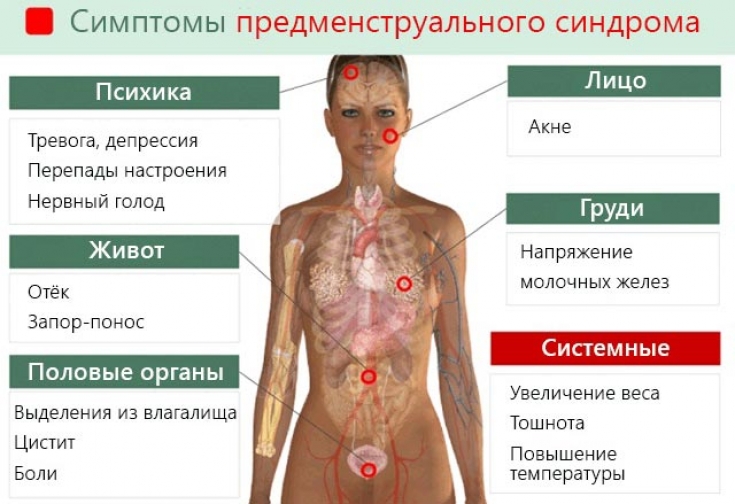Premenstrual Syndrome, also known as PMS – it is a collection of physical and emotional symptoms that occur in the last phase of the menstrual cycle and reduce the quality of a woman's life. About 30% of the beautiful half of humanity regularly feels the symptoms of PMS, 5% of them have severe premenstrual syndrome.
The etiopathogenesis of premenstrual syndrome is not a fully understood aspect, which is why the therapy of this condition in many cases is not justified. Prescribing expensive drugs without proven efficacy is, unfortunately, a popular but unacceptable practice today. Knowledge of modern and effective approaches to the treatment of PMS should be owned by endocrinologists, gynecologists, general practitioners, psychiatrists and psychotherapists, as well as all specialists interested in this problem.
For more information about the treatment of premenstrual syndrome according to international recommendations, read on estet-portal.com in this article.
Key pathogenetic mechanisms of development of premenstrual syndrome
The mechanism of development of premenstrual syndrome is not fully understood. Back in 1931, Robert Frank proposed the hormonal theory of PMS. According to the latter, premenstrual syndrome is a consequence of a violation of the ratio of progesterone and estrogen in the luteal phase of the menstrual cycle.
According to the current view, the key moment in the development of premenstrual syndrome is a violation of the metabolism of progesterone in the central nervous system, which leads to excessive formation of the GABA receptor antagonist – pregnenolone.
GABA inhibition explains the characteristic symptoms of PMS, such as lowered mood and irritation. Therefore, the expediency of prescribing serotonin reuptake inhibitors in the treatment of premenstrual syndrome becomes clear.
A certain role in the development of PMS belongs to disorders in the renin-angiotensin-aldosterone system, which explains such symptoms of PMS as swelling of the lower extremities and a tendency to hypertension.
Read also: Pain and discomfort during menstruation: approaches to the treatment of dysmenorrhea
Emotional and physical clinical manifestations of premenstrual syndrome
Premenstrual syndrome is characterized by a wide variety of various clinical manifestations. The following most common symptoms of PMS should be highlighted:
1. Emotional: dysphoria, mood swings with a tendency to depression, unreasonable outbursts of anger, fatigue, insomnia, change in appetite;
2. Physical: headache, swelling of the extremities, pain in the heart, nausea and vomiting.
Most of the time, the onset of PMS symptoms occurs during the second phase of the menstrual cycle. Depending on the number of predominant symptoms, mild (3-4 symptoms) and severe (more than 5 symptoms) variants of premenstrual syndrome are distinguished.
Follow us on Telegram
Modern and effective approaches to the treatment of premenstrual syndrome
Premenstrual syndrome can be a reason for a woman to seek help from a gynecologist, endocrinologist or even a psychotherapist. A key aspect of the treatment of this condition is an explanation to the woman of the nature of the occurrence of the symptoms that disturb her. It is also recommended to reduce the consumption of coffee and alcohol.
Increased physical activity, taking magnesium, calcium, vitamin B6 supplements can significantly reduce the severity of premenstrual syndrome.
Change in lifestyle, as well as the use of vitamin B6 at a dose of 100 mg, magnesium at a dose of 400 mg, and calcium supplements are recommended by international protocols for the treatment of premenstrual syndrome and are effective in most cases. However, sometimes these measures are not enough, and it becomes necessary to prescribe hormonal medications and antidepressants.

What medications are effective in the treatment of premenstrual syndrome
According to international protocols, it is advisable to use the following medications in the treatment of premenstrual syndrome: selective serotonin reuptake inhibitors, combined oral contraceptives, levonorgestrel-releasing intrauterine systems, gonadotropin-releasing hormone agonists, diuretics.
Selective serotonin reuptake inhibitors must be taken cyclically from the middle of the menstrual cycle until the onset of menstruation. In the treatment of premenstrual syndrome, it is advisable to use small doses of these drugs (less than in the treatment of depression). In particular, taking fluoxetine 20 mg qd or citalopram 10 mg qd has been shown to improve PMS symptoms in many cases.
The use of combined oral contraceptives containing drospirenone is also effective in reducing the manifestations of premenstrual syndrome. In this case, the hormone-free interval should be shortened to four days.
Combined oral contraceptives: current recommendations for specialists
also helps to eliminate the manifestations of premenstrual syndrome. This active substance inhibits the secretion of pituitary gonadotropic hormones, inhibits insulin-like growth factor-1, specifically interacts with GABA receptors (gamma-aminobutyric acid). Taken together, these pharmacodynamic effects of levonorgestrel contribute to the reduction of symptoms of PMS. In severe cases of premenstrual syndrome, it is necessary to consider the possibility of prescribing drugs from the group of gonadotropin-releasing hormone agonists (GnRHa). They inhibit the functioning of the ovaries and lead to a hormonal state similar to postmenopausal, thereby reducing the symptoms of PMS.
Gonadotropin-releasing hormone agonist drugs should be used in conjunction with estrogens/progestogens to reduce the risk of osteoporosis.
A small dose of a diuretic (eg, spironolactone 25 mg/d) for several days is appropriate to reduce swelling as a symptom of PMS.
Effective elimination of the manifestations of premenstrual syndrome can restore a woman's physical, mental and social well-being, increase her ability to work and improve her quality of life.
Thank you for staying with estet-portal.com. Read other interesting articles in the "Gynecology" section. You may also be interested in
Mechanism of development and symptoms of menopause in women.







Add a comment